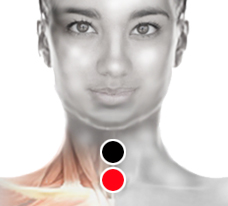Cyanosis
Pair
larynx - larynx

Generalities:
Cyanosis is the bluish discoloration of the skin, mucous membranes and nails. In most cases it is due to a lack of oxygen in the blood: concentrations equal to or greater than 5 g/dL of hemoglobin without oxygen in the blood vessels near the surface of the skin. It may also be due to the presence of abnormal hemoglobin pigments (methemoglobin or sulfhemoglobin) in the red blood cells.
Because cyanosis depends on the amount and not on a percentage of deoxygenated hemoglobin, it is much easier to find it in states with an increase in the volume of red blood cells (polycythemia) than in those cases with a decrease in the erythrocyte mass (anemia). It may be difficult to detect in patients with highly pigmented skin. Although human blood always has a reddish color (except in rare cases of hemoglobin-related diseases). During cyanosis, tissues have unusually low concentrations of oxygen, and therefore tissues that are normally filled with bright, oxygenated blood become filled with dark, deoxygenated blood. Dark blood is much more prone to optical effects, and therefore oxygen deficiency (hypoxia) leads to bluish discoloration of the lips and other mucous membranes. The name is derived from the color cyan, which means "blue."